Duolingo CEO and co-founder Luis von Ahn was tired of the gray and dreary design aesthetic edtech companies used to emulate universities. Instead, he and the company’s early team sought inspiration from games like Angry Birds and Clash Royale, looking to build a class that screamed more cartoon anarchy than lecture hall. From that frenetic creativity came the company’s distinctive mascot: a childish and rebellious evergreen-colored owl named Duo.
Duolingo didn’t just throw out the old colors though — it wanted to completely rethink language learning from the bottom up for mobile. So it replaced top-down curriculums with analytics-driven growth strategies, becoming consumed by an ethos that has more recently been dubbed product-led growth.
Used by companies such as Calendly, Slack and Dropbox, product-led growth is a strategy in which a company iterates its product to create loyal fans-turned-customers who popularize the product with others, creating a viral growth loop. It’s an attractive route because it vastly lowers the cost of acquiring users while also increasing engagement and thus retention. Duolingo, for example, has taken this model and found ways to embed engagement hooks, pockets of joy and addictive education features within its core app.
With early venture capital in its pocket, Duolingo could afford to focus on product over profits.
In part one of this EC-1, we explored how von Ahn’s previous products around CAPTCHA led to Duolingo’s launch, the rise and fall of crowdsourced translation as a way to disrupt language learning, and the accidental iteration of a top education app by a pair of interns. The startups’ early signs of success gave it energy to focus on growth to accomplish two things: know what they’re doing works, and garner a lot of user data so it continued iterating the product into something that was ever more addicting to use.
Now, we’ll analyze how Duolingo used product-led growth as a lever to expand its consumer base, and how a company built on gamification tries to balance its whimsy with education outcomes.

From Angry Birds to an amusing and sometimes scowling owl
Tyler Murphy, having graduated from his intern position at Duolingo launching the company’s iOS app, noticed that the gaming world was rapidly innovating around him in the mid-2010s. Angry Birds was no longer the only popular game on mobile, and video games generally were getting more engaging, with in-app currencies, progress bars and an experience that felt creatively addictive. He suddenly saw connections between the entertainment that games provided and the patient learning required for languages.
“Wouldn’t it be cool if the skill got harder and harder, kind of like how a character in a game gets more powerful and powerful?” he remembers asking. Duolingo had taken early inspiration from Angry Birds as well as Clash Royale later, following that game’s launch in 2016. “Half the people at Duolingo were playing Clash Royale, at some point,” he said. “And I think that shaped our product roadmap a lot and our design language a lot.”
Games solved a problem that was acutely personal for Murphy. The employee, who would go on to become chief designer at Duolingo, had gone to college to teach Spanish to students, but ultimately left the field after struggling to inspire kids in a classroom setting. The realization that Duolingo could borrow from gaming instead of monotonous edtech companies gave an adrenaline rush — and permission — to the team to experiment with new approaches to learning.
Every game needs some form of experience points and leveling up, and for Duolingo learners, that progress comes in the form of skill trees.
These trees, which were conceived by a design agency during the company’s early development, are Duolingo’s core experience, a visual representation of language skills that are interconnected and get progressively more difficult and refined over time. Each skill is a prerequisite for another. Sometimes it’s just logic: in order to be able to speak about restaurants, you probably should be able to introduce yourself first. Sometimes, however, it’s a necessary building block: in order to speak about your routine, you should be able to speak about basic everyday activities.
In Duolingo, each unit has its own suite of skills, each of which is broken down into five lessons. Once you complete all five lessons, you can move to the next skill. Complete all skills and you can move to the next unit. Depending on the language, a user might encounter an average of 60 skills across nine different units within a course.
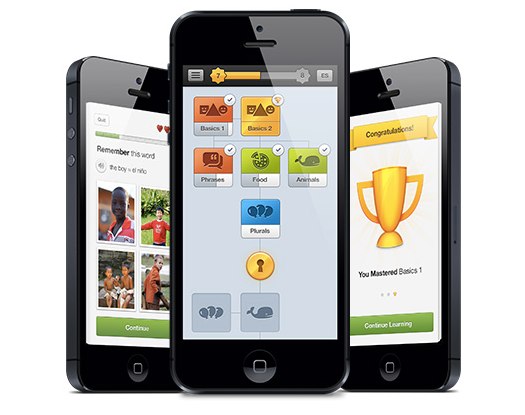
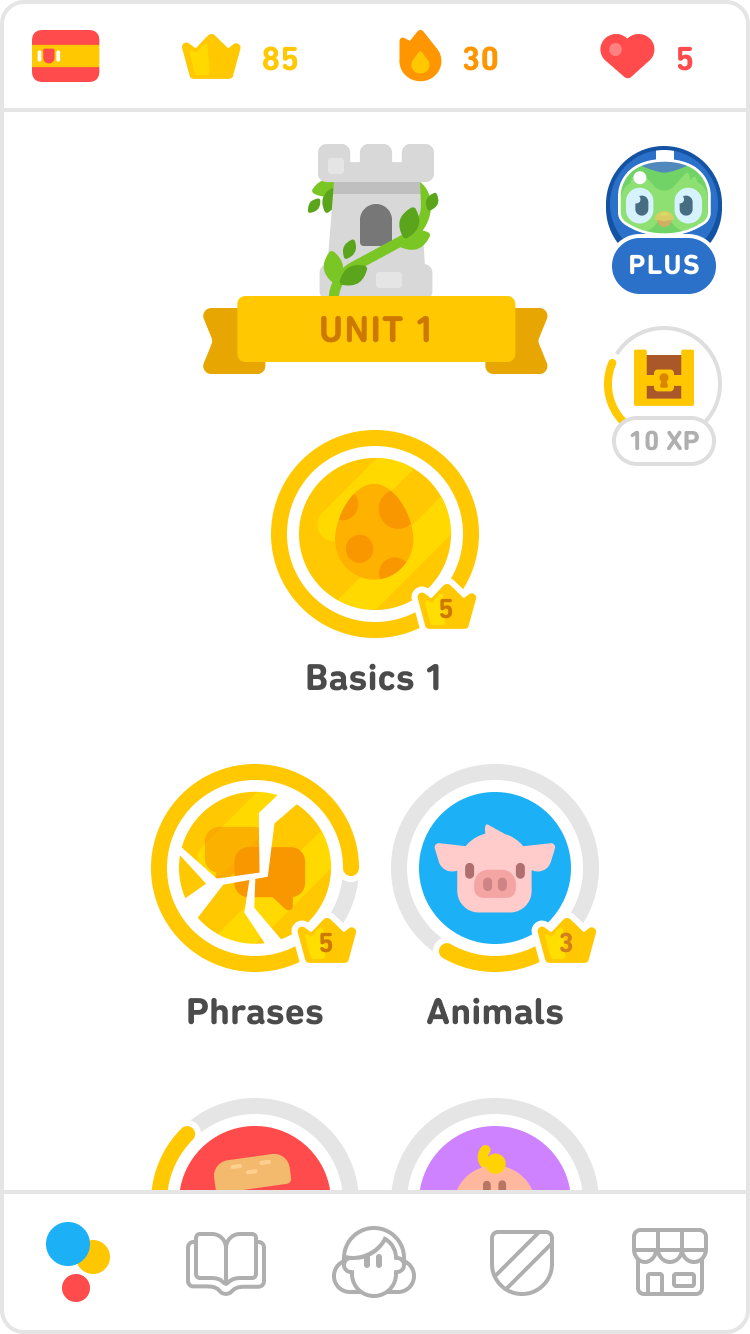
The growth power of a cartoon owl meme
Duolingo had its “leveling up” model figured out, but now it had to integrate gamification into every nook and cranny of its app. One of its first challenges was rebuilding the sort of teacher-student emotional bond that can help students stay motivated to learn. No one likes to fail, and Duolingo stumbled upon a scalable approach through its cartoon owl mascot Duo — also thought of by the design agency behind the skill trees.
Whenever users succeed or fail at their lessons today, they are likely to be encouraged or admonished by Duo’s presence. Designers sprinkled Duo throughout the product, looking at Super Mario Brothers as an example of how to use iconic art to create a friendly gaming experience. In early iterations of the app, Duo was present but static, more of an icon than a personality. That changed as the company increasingly pushed harder on engagement.
Duolingo is notorious for unapologetically sending daily push notifications to get people to open the app. It uses artificial intelligence and algorithms to pick from hundreds of possible reminders and messages to help drive up engagement — and of course, guilt trip users into doing a lesson, often delivered with Duo’s presence hovering over the user.
While the notifications certainly work, users saw an opportunity to poke fun at the passive aggressiveness of some of these messages. As the app’s popularity soared and Duo’s presence became more and more ubiquitous, users responded as you’d expect them to: They made memes of Duo threatening them to learn languages.
— Elbardo (@Elbardo_ts) March 26, 2019
When the memes first started percolating, Murphy said it clashed with Duolingo’s style of consistent design and desire to be an iconic brand. At the same time, the rise of meme and remix culture could be an opportunity more than a controversy. After all, when’s the last time you saw user-generated art about practicing Hindi vocabulary?
“It was after the memes that we thought to intentionally show Duo’s emotional range,” Murphy said. “Let’s show him angry, and all of these emotions that you usually don’t want associated with your brand. The memes gave us permission to fuel what people were already making.” Now, when you get a question right, Duo might congratulate you with a dance. When you don’t practice for a day, Duo might pop onto your screen with puppy-dog eyes.
https://twitter.com/lazycamgirl/status/1322610979532808192
Duo and those push notifications were even the subject of an April Fool’s joke Duolingo did in 2019: You could hire Duo to arrive in-person and physically push you to start practicing a language. There’s even a whole page dedicated to Duo fan art, and you can add Duo as a filter on Instagram.
LOVE the @duolingo fan art and love having a brand that encourages people to draw it! pic.twitter.com/tMl6F5MWok
— Luis von Ahn (@LuisvonAhn) July 4, 2020
More recently, Duolingo introduced a whole cast of characters for users to get attached to — adding character and culture into the app and deepening the emotional bond first built with Duo. The Duolingo Universe is inspired by the Super Mario Brothers empire. The crossover strategy from gaming and movies has helped fuel Duolingo’s rise and represents one of its most consistently performing product-growth strategies.
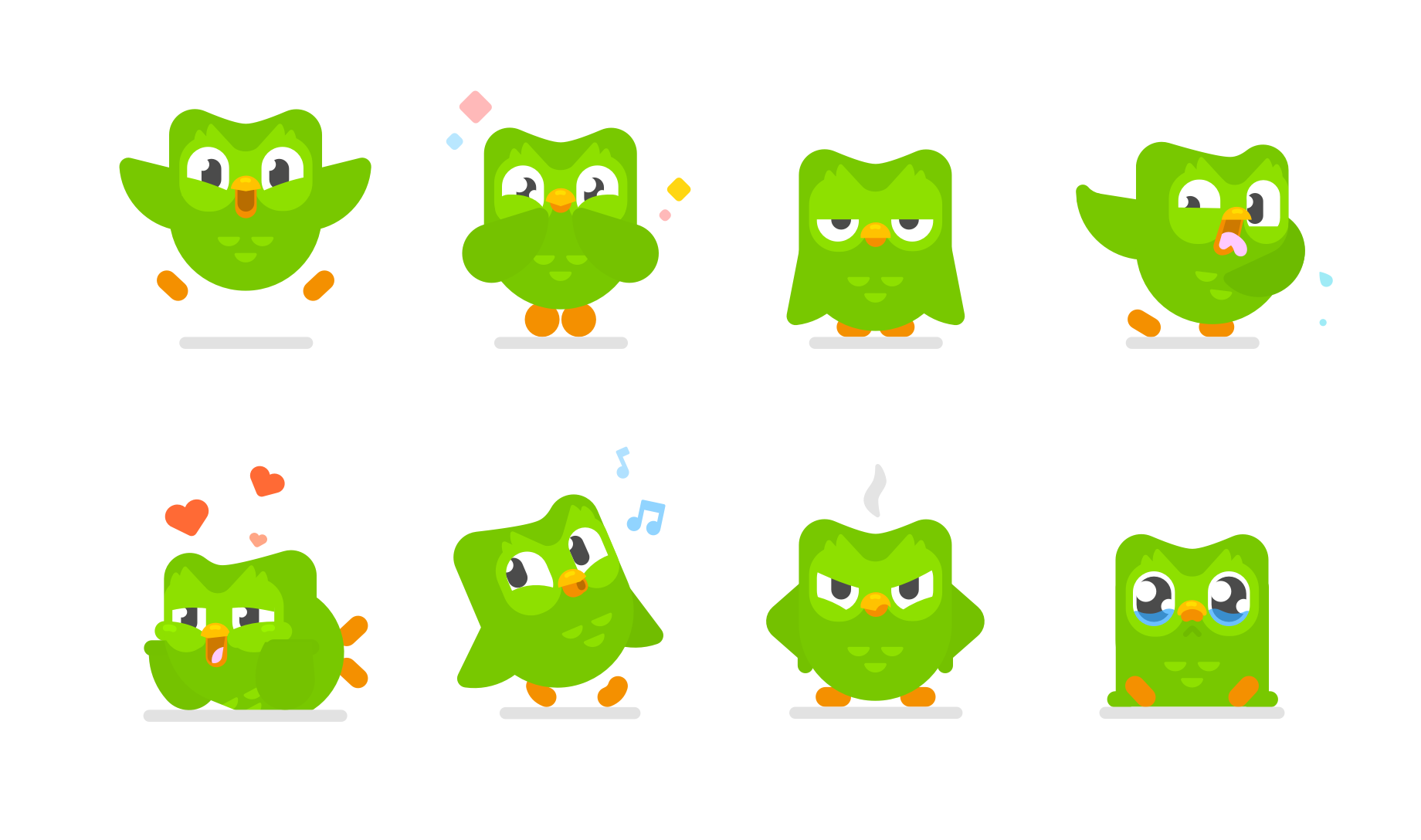
Leaderboards, streaks and (broken) hearts
Duolingo has not only borrowed the idea of characters from gaming, but also remixed many other gaming concepts to increase engagement, retention and hopefully language learning in its app.
Leaderboards, for example, give users the ability to compete with other users across the world at a similar experience level. Spanish beginners will be pitted against other Spanish beginners, and the more experience points you gain, the higher you sit on the board. It’s a feature that ties into the innate human need to be competitive. As one Twitter user put it:
https://twitter.com/cescaventaniIIa/status/1382991419925798912
“Leaderboards single-handedly increased the time that people spent on Duolingo by 20%,” von Ahn said proudly. “Half the users like competition, and those people really go nuts on the leaderboards. It’s a very, very persuasive feature.”
That competitive nature is good for the app’s growth, although educators have long been hesitant to make any learning space a more competitive environment where there are a few winners and many implied losers.
Another persuasive feature in Duolingo is streaks, or a visual representation of how many days in a row a learner has completed at least one lesson in the app. The company’s push notifications are often tailored around streaks, and these personalized notifications can increase engagement for millions of users.
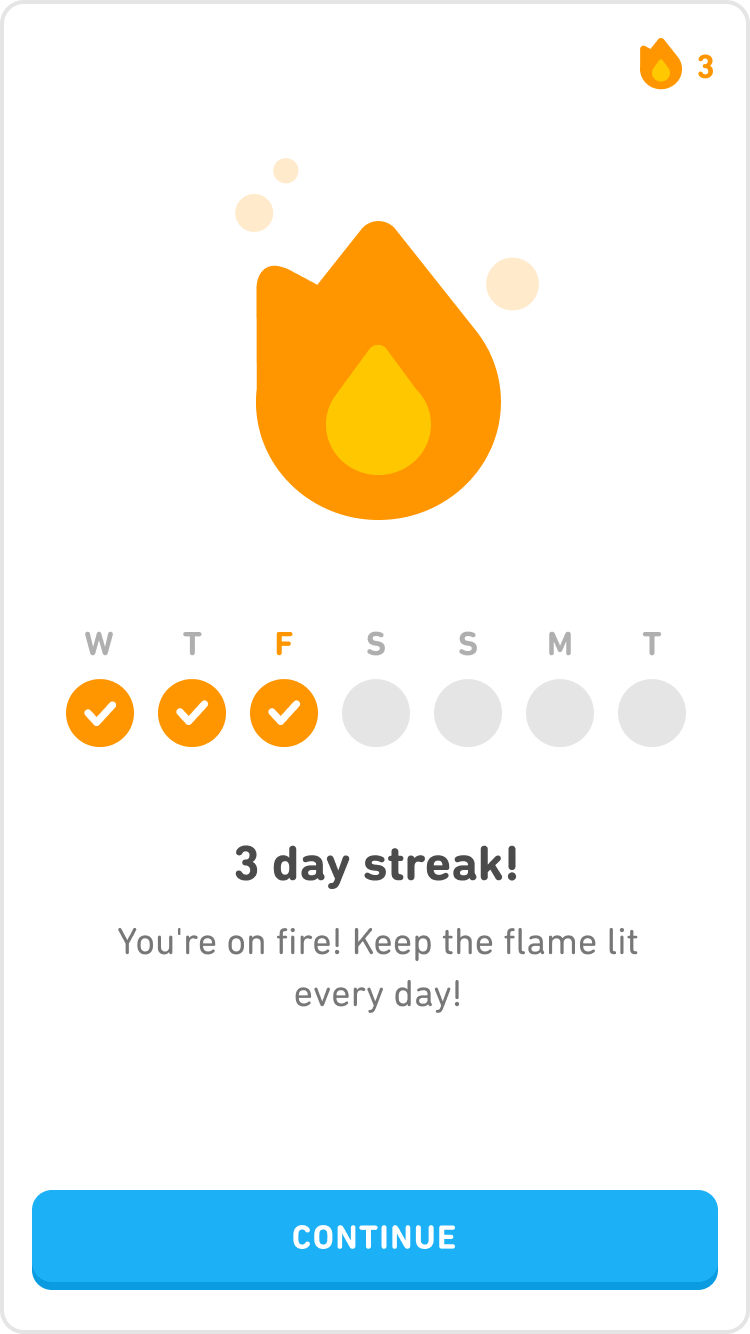
Streaks, an engagement hack also used by the Apple Watch, Snapchat and the NYT Crossword app, play on the human need for validation and satisfaction. We like to visualize progress and get rewarded for it — so much so that breaking a streak can bring sadness or discomfort. The company launched an in-game currency, called lingots or gems, that users could use to buy power-ups while they learn. These power-ups could be used to buy a streak freeze, for example, that would allow you to maintain a streak if you happen to miss a day.

Duolingo claims that over 50% of its active users have a seven-day streak or higher.
In addition to increasing engagement, streaks also are a surprisingly good mechanism for viral growth. Users often flex their hundred-day or thousand-day streaks by posting major milestones to social media, which not only gains the company more attention, but authentic attention that some users have used the app daily for literally years. That’s free advertising you can’t buy, and FOMO you can’t force.
While streaks are perfect for engagement, their educational purpose is a little more muddled. They might be a good way to incentivize someone to consistently practice a language, but how thoughtful that engagement is remains a question. In order to get another day added to your streak, a user just has to complete one quick lesson. If all a user wants to do is maintain a streak, they can do so without truly committing to learning the language and comprehending it. In other words, Duolingo might be good at making Duolingo a habit — but not actual language learning.
Users for the most part can completely avoid both leaderboards and streaks if they so choose, but the third major engagement strategy the company employs is a bit harder to evade.
Inspired by the Zelda game franchise, Duolingo has a feature it calls hearts. Every day, a user is offered a set amount of hearts, a proxy for “lives.” Whenever a user makes a mistake, they lose a heart. If they lose all of their hearts, they are locked out of the lesson for a few hours. Hearts force users to pay attention when completing a lesson, similar to the red-ink circle around an error one might receive on an exam. If you consistently make mistakes, you’ll be penalized by not being able to finish a lesson — and potentially lose your streak. The goal is to increase learning comprehension while adding a bit of “danger” to the app for those not paying close attention.
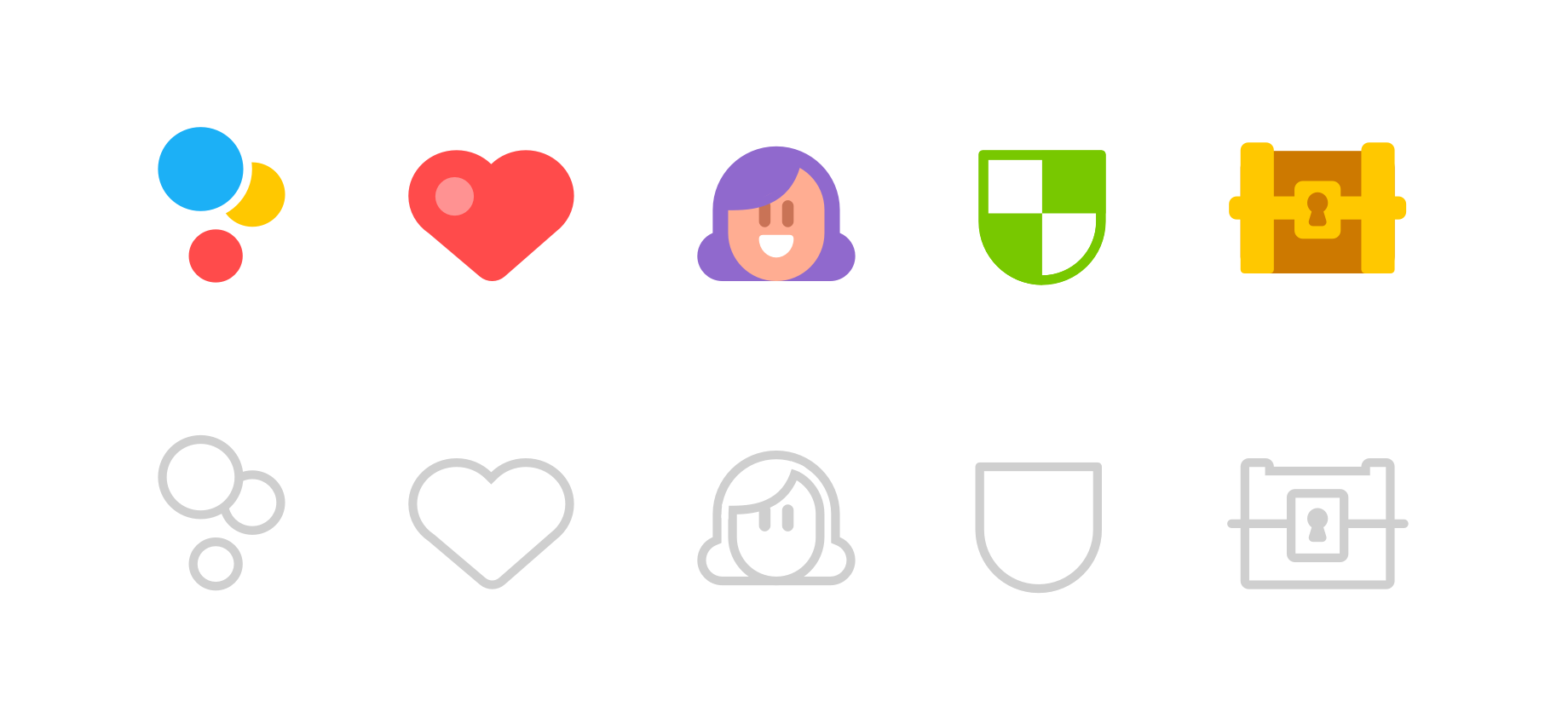
“Hearts are our most controversial feature to date,” Karin Tsai, director of engineering and an early employee, said. “Part of learning is making mistakes, why are we punishing people for making mistakes?” Some educators encourage students to make mistakes so they learn from it — while Duolingo will shut off your access to the next question if you keep making the same error.
While there is not always extremely close alignment between pedagogy as used in a classroom and Duolingo’s growth strategies, the two are broadly convergent. Duolingo can always lean back on the fact that learning is a healthy habit.
“We hope that this is the one game that you are okay being addicted to because it is good for you,” Murphy said. “We try to make sure the things we get you hooked onto are aligned to the things that have the highest learning value.”
A/B (language) testing
Popularized by San Francisco-based Optimizely, A/B testing is a method to trial experimental versions of a product to different slices of users to understand how they react.
For obvious reasons, the strategy is popular when a startup is beta-testing new features or products. Developers can optimize for the more attractive option instead of innovating in the dark. One example could be trying out two headlines in a newsletter product, seeing which gets the most clicks, and opting for that choice when sending the newsletter out to the rest of the email list. In Duolingo’s case, a product team might test two versions of a similar push notification and see which performs better.
Because the startup relies so much on subtle but effective and inclusive gamification, it’s consistently and rapidly testing different features. At any given point, there might be 100 different A/B tests running. The Duolingo analytics team built a dashboard so that every experiment that Duolingo conducts has a nightly generated report where employees can see the impact of their experiments.
One quirk about Duolingo is that its product team usually tests its new features in the French course for English speakers before rolling it out to other languages. This is because the team can get statistically significant results faster, since the course is more popular among users. In contrast, if a team tested a feature in the Hindi course for English speakers, it would take a longer time to get useful results.
An even more popular course at Duolingo is Spanish for English speakers, but the team intentionally stays away from testing in that course because too many senior product people at Duolingo know Spanish. The product leadership worries that thoughts of fluent nonlearners could bias the statistical data from its A/B tests.
While much of Duolingo’s product changes are universal around the world, there are localization nuances that come from scaling a language-learning app globally. For example, in China, the startup asks users for their phone number instead of email address because the latter isn’t commonly used there. In India, users weren’t being shown the English courses for Hindi speakers because the language setting on their phones was set to English, which the team had to fix. In addition, the company consistently focuses on app latency so it can operate in developing countries.
Building in guardrails to change
Product leaders are encouraged to experiment and add or change features, but Duolingo has a number of guardrail metrics, or metrics it doesn’t want to decrease with the roll out of a new feature. These metrics include current user retention rate, daily active user count in non-English-speaking countries and app latency. Being explicit about guardrail metrics helps Duolingo’s employees make sure they aren’t inadvertently hurting core metrics while pursuing others.
Every startup has to sacrifice certain opportunities in the pursuit of others, and at Duolingo, that sacrifice translates to education in exchange for engagement, or vice versa.
“We’re trying to do things that no other apps really tackle: How do we create an experience that actually makes you extremely proficient in a language while accommodating the expectations from our learners” to be fun and convenient, Tsai said. “Balancing efficacy with engagement is something that we constantly struggle with.”
Retention works, and Duolingo outlasts many of its competitors in terms of users consistently coming back to the app. But even retention is not a replacement for effectiveness. In reality, most people don’t have the drive, motivation or comprehension capabilities to learn from a bite-sized lesson, even if they go through the motions.
Tsai admits that Duolingo spent years trying to figure out how to find a metric that could encompass learning comprehension and engagement in one fell swoop.
“What used to freeze us is that we thought we would need such a metric to make progress,” Tsai said. “And I think what honestly liberated us was saying essentially, ‘Screw it.’ We couldn’t make progress waiting for a learning metric.”
Because Duolingo isn’t able to use its guardrail ethos on one single learning metric, the balancing act gets a little more precarious. Even if each feature is intended to be both gamified and educational, if one is easier to measure than the other, clearly the measured outcome will take priority.
Through its mascot, gamification features and a rigorous testing culture, Duolingo has been successful at creating an addicting, free app. But as a platform grows, the pressures change. For Duolingo, hitting massive user growth meant that it had to find a way to afford its mission. Users were coming in droves — forcing the company to spend about $42,000 per day on its servers, employees and other operating expenses.
Von Ahn’s promise from launch began to age poorly: “No ads, no hidden fees, no subscriptions, just free,” the trailer continued. Five years later, Duolingo would be doing most of those things, and more, which is where we turn to next in part three of this EC-1.
Duolingo EC-1 Table of Contents
- Introduction
- Part 1: Origin story
- Part 2: Product-led growth strategy
- Part 3: Monetization
- Part 4: New initiatives and future outlook
Also check out other EC-1s on Extra Crunch.
Updated May 3, 2021: The Skill Tree was developed by Luis and the early Duolingo Designers, not by the design agency as originally written.































Comment